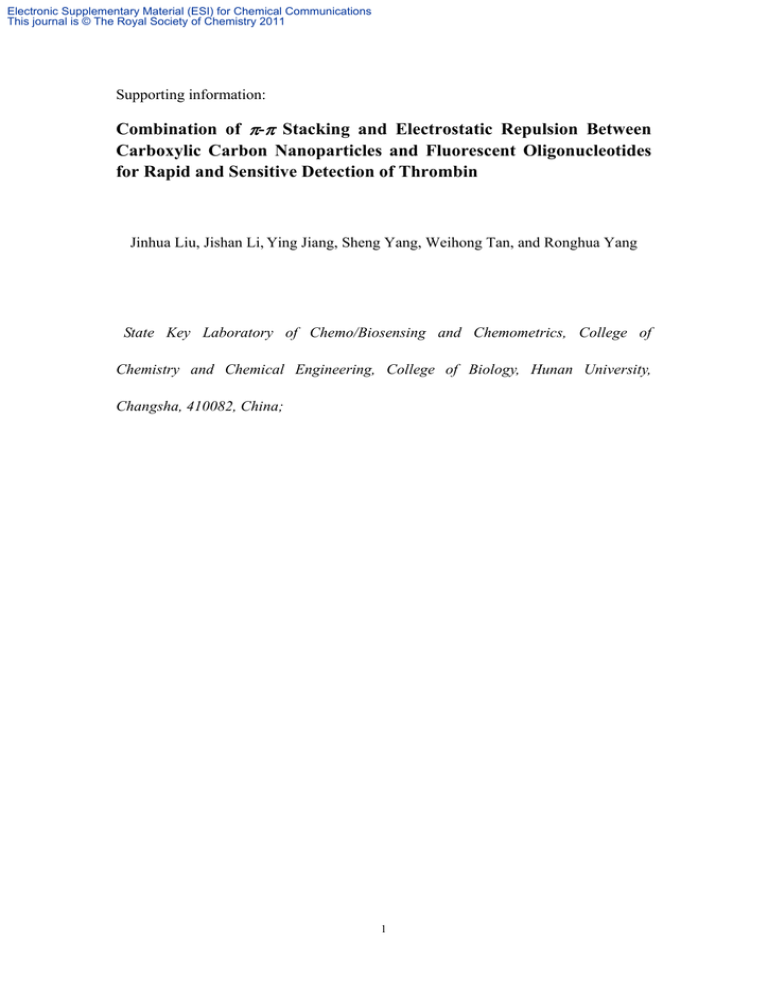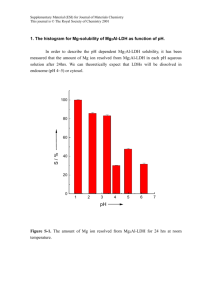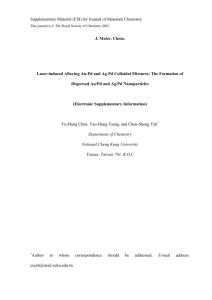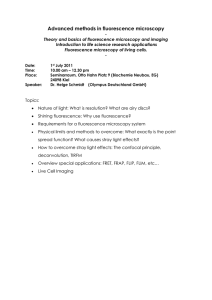Combination of π-π Stacking and Electrostatic Repulsion Between
advertisement

Electronic Supplementary Material (ESI) for Chemical Communications This journal is © The Royal Society of Chemistry 2011 Supporting information: Combination of - Stacking and Electrostatic Repulsion Between Carboxylic Carbon Nanoparticles and Fluorescent Oligonucleotides for Rapid and Sensitive Detection of Thrombin Jinhua Liu, Jishan Li, Ying Jiang, Sheng Yang, Weihong Tan, and Ronghua Yang State Key Laboratory of Chemo/Biosensing and Chemometrics, College of Chemistry and Chemical Engineering, College of Biology, Hunan University, Changsha, 410082, China; 1 Electronic Supplementary Material (ESI) for Chemical Communications This journal is © The Royal Society of Chemistry 2011 Experimental Apparatus and Chemical . Fluorescence measurements were performed on a PTI QM4 Fluorescence System (Photo Technology International, Birmingham, NJ) with a temperature control accessory. The microstructures of the CNPs were examined using a JEOL JSM-6700F scanning electron microscope (SEM) and a multimode AFM (SPI3800N-SPA400, Seiko Instrument) having a piezoscanner with a maximum scan range of 100 µm × 100 µm × 5 µm. Samples for SEM analysis were prepared by pipetting 10 µL of the colloidal solutions onto the silicon surfaces. The samples were dried in air for > 10h before they were loaded into the vacuum chamber of the electron microscope. XPS measurements were carried out on an Axis Ultra Imaging Photoelectron Spectrometer (Kratos Analytical Ltd., UK). Monochromatic Al K X-rays (1486.7 eV) were employed. The X-ray source was 2 mm nominal X-ray spot size operating at 15 kV, 15 mA for both survey and high-resolution spectra. Survey spectra, from 0 to 1100 eV binding energy (BE), were recorded at 160 eV pass energy with an energy step of 1.0 eV and a dwell time of 200 ms. High-resolution spectra were recorded at 40 eV pass energy with an energy step of 0.1 eV and a dwell time of 500 ms, with a typical average of 12 scans. The operating pressure of the spectrometer was typically ~10-9 mbar. All data were collected and analyzed using software provided by the manufacturer. Thrombin aptamer was synthesized by Shanghai Biotech (China) and labeled at end with FAM dye. Thrombin was bought from Sigma (U.S.A.). Bovine serum albumin (BSA) and human IgG antibody were from Dingguo Biotech (Beijing,China). All work solutions were prepared with 0.1 M Tris-HCl buffer solution (pH 7.2, 50 2 Electronic Supplementary Material (ESI) for Chemical Communications This journal is © The Royal Society of Chemistry 2011 mM KCl, 10.0 mM MgCl2). The Preparation of cCNPs. Pristine CNPs was obtained from candle soot. To prepare cCNPs, 4.0 mg pristine CNPs was mixed with 2.0 ml HNO3 (63%) and 2.0 ml DMF, and stirred for 12 h at 100 C. After cooling down to room temperature, the upper 80% of the clear solution was removed by ultracentrifugation and the resulting dark powders were collected. The collected precipitates were cleaned with distilled water and subsequently centrifuged at 14000 rpm for 10 min more than three times. After dried at 60 C for 3 h, 2.4 mg cCNPs were obtained. We prepared the cCNPs stock solution by dissolving 2.0 mg of the cCNPs powders in 1.0 ml highly pure water, the concentration of cCNPs solution of 2.0 mg/ml was received. Potentiometric pH Titrations. The potentiometric pH titration experiments were carried out with an ionic strength of 0.1 M NaNO3 at 25C. All measurements were performed with an electrode connected to a PHS-3C pH meter (Shanghai, China) at 0.1mg/mL cCNPs. The electrode was calibrated using standard buffer solutions and no corrections were made to pH values determined in the aqueous solution. The FORTRAN program BEST was used to process the potentiometric data and calculate the deprotonation constant. Fluorescence Quenching and Detection of Thrombin. The working solution of the fluorescent oligonucleotide (P) was obtained by diluting the stock solution to about 30nM with the Tris-HCl buffer. An aliquot of the cCNPs solution (less than 3%, v/v) was added to Tris-HCl buffer containing P and was allowed to incubate for 5-10 min. For detection of thrombin, the fluorescence titrations of P-cCNPs system with 3 Electronic Supplementary Material (ESI) for Chemical Communications This journal is © The Royal Society of Chemistry 2011 different concentrations of thrombin were carried out by adding a few microliters of a stock solution of the targets to 500 L of P-cCNPs solution with a quartz cell (1.0 × 1.0 cm2 cross section). After incubation for ~25 min at room temperature, the fluorescence emission spectra were recorded. The time dependent experiments were conducted by monitoring fluorescence at different incubation times. In specificity studies, the cCNPs aptasensor was incubated with 1.0 µM BSA, 1.0 µM IgG, and 300 nM thrombin in buffers for the same incubation time, respectively. For compare the sensitivity of ‘‘post-mixing’’ strategy and ‘‘post-mixing’’ strategy, signal-to-background ratio (S/B), which is defined as S/B = (Fhybrid-Fbuffer)/ (Fprobe-Fbuffer), was used. Where Fprobe, Fbuffer, and Fhybrid are the fluorescence intensities of the probes without target, plain buffer solution, and the probe-target complex, respectively. 4 Electronic Supplementary Material (ESI) for Chemical Communications This journal is © The Royal Society of Chemistry 2011 60.00 h / nm 40.00 20.00 0.00 0 1 2 I / m Fig. S1. AFM image and depth profiles of as prepared cCNPs.Size:4.0 x 4.0 m. 1720 1598 98.00 97.00 3200 2400 1600 Wavenumber/cm 1250 99.00 3380 Transmittance/% 100.00 800 -1 Fig. S2. FT-IR spectroscopy of pCNPs (blue curve) and cCNPs (red curve). 5 Electronic Supplementary Material (ESI) for Chemical Communications This journal is © The Royal Society of Chemistry 2011 Percentage(%) 50 pCNPs 40 cCNPs 30 20 10 0 C-C C-O C=O O N S Figure S3. The relative percent of oxygen and oxygen-containing carbon species on the surface of the pCNPs and cCNPs. 9.00 pH 8.00 7.00 6.00 5.00 0 4 8 12 16 NaOH/ml Figure S4. Potentiometric equilibrium curves of 0.1mg/ml of cCNPs at 25°C (• is the experimental data). 6 Electronic Supplementary Material (ESI) for Chemical Communications This journal is © The Royal Society of Chemistry 2011 10.0 mM Mg2+ 2+ no Mg 120 QE(%) 90 60 cC NP s P1 + P1 +p CN Ps +c CN Ps FA M FA M 0 +p CN Ps 30 Fig. S5. Fluorescence quenching efficiencies (QE%) of FAM and P by 0.02 mg/ml pCNPs or cCNPs in the Tris-HCl buffer solution without (gray) or with (black) 10.0mM Mg2+ ions. The magnitude of the error bars was calculated from the uncertainty given by three independent measurements. Fluorescence emission intensity was recorded at 520 nm with an excitation wavelength of 480 nm. P 5 Fluorescence intensity(10 ) 16 adding 12 8 adding MgCl2 4 0 0 3 6 9 12 15 Time/min Fig. S6. Time course of interactions of P (30nM) with cCNPs (0.02 mg/ml) before and after addition of 10.0mM MgCl2 in the Tris-HCl buffer solution at room temperature. The transitions between each regime are marked with an arrow. Fluorescence emission intensity was recorded at 520 nm with an excitation wavelength of 480 nm. 7 Electronic Supplementary Material (ESI) for Chemical Communications This journal is © The Royal Society of Chemistry 2011 12 5 Fluoresence intensity(10 ) 6.0 a S/B 9 4.5 6 3 b 0 0 200 400 600 800 3.0 logC/nM 1.5 0.0 520 560 600 640 Wavelength/nm Fig. S7. Fluorescence emission spectra of aptamer-cCNPs in the presence of different concentrations of Tmb (10, 30, 60, 90, 120, 240, 360, 480, 600, 700, 800nM) in two hours. (Inset: Relative fluorescence is calculated from the fluorescence intensity ratio of S/B. The S/B indicates the signal changes of P with (a) and without cCNPs (b) as increases in the Tmb concentrations.) 300nM 120nM 60nM 30nM 0nM 5 Fluorescence intensity(10 ) 2.0 1.6 1.2 0.8 0.4 0 20 40 60 80 Time/min Fig. S8. Kinetic study for the fluorescence change of the cCNPs-bond P in the presence of thrombin of various amounts (0, 30, 60, 120, 300 nM) via time. The excitation and the emission wavelengths are 480 and 520 nm, respectively. 8 Electronic Supplementary Material (ESI) for Chemical Communications This journal is © The Royal Society of Chemistry 2011 Tmb 5 Fluorescence intensity(10 ) 20 45 S/B cCNPs 16 30 15 12 0 0 150 300 450 C(nM) 8 4 0 5 10 15 20 25 Time/min Fig.S9. Kinetic study for the fluorescence change of the P mixing with thrombin of various amounts (5, 30, 60, 120, 300, 500 nM) in the presence of 0.015mg/ml cCNPs via time. Inset: S/B of mixing thrombin of various amounts. The excitation and the emission wavelengths are 480 and 520 nm, respectively. Table S1: XPS Compositional Analysis of cCNP (top) and pCNP (bottom)* Name O 1s O 1s C 1s C 1s C 1s N 1s N 1s S 2p S 2p Position 531.42 531.85 284.52 284.50 287.98 401.17 401.08 168.72 168.74 FWHM 3.354 3.318 2.727 2.541 3.569 2.272 4.195 3.411 3.347 R.S.F. 0.78 0.78 0.278 0.278 0.278 0.477 0.477 0.668 0.668 Area% 7158.4 7208.7 5988.3 4639.2 1363.6 553.1 475.8 584.9 593.5 Conc. 14.017 14.115 32.900 25.488 7.492 1.771 1.523 1.337 1.357 Name Position FWHM R.S.F. Area% Conc. O 1s 531.91 3.043 0.78 16924.3 7.026 O 1s 532.01 3.113 0.78 17169.3 7.128 C 1s 284.52 2.515 0.278 34694.5 40.414 C 1s 284.50 2.487 0.278 27430.3 31.952 C 1s 287.88 6.099 0.278 7453.3 8.682 N 1s 401.66 0.763 0.477 1925.4 1.307 N 1s 401.64 3.333 0.477 1550.2 1.052 S 2p 168.52 2.844 0.668 2502.6 1.213 S 2p 168.90 2.827 0.668 525.9 1.225 *The data were provided by “Analytical Center of Peking University” 9



